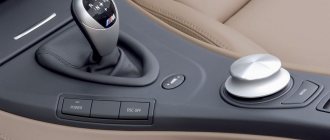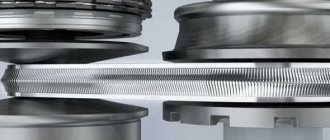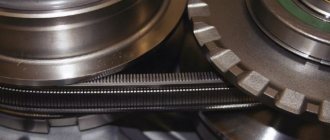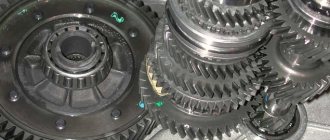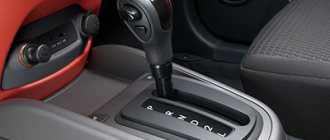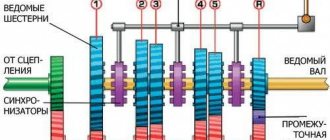Today, automatic transmission is at the peak of its popularity around the world. At the same time, manufacturers offer consumers various types of machines.
More precisely, there are hydromechanical automatic transmissions, CVT gearboxes, as well as robotic gearboxes with one clutch (AMT) and preselective robotic gearboxes with two clutches.
Each of these types of gearboxes differs from analogues in design, and also has certain advantages and disadvantages. In this article we will talk about the difference between a variator and a “classic” automatic transmission, what is the difference between an automatic transmission and a robot and a variator, etc.
Design and operation of the variator
The variator structurally consists of:
- driving/driven pulleys, shafts;
- steel belt;
- starting clutch (centrifugal, multi-disc, electromagnetic, torque converter);
- planetary gear satellite;
- oil pump;
- bearings;
- hydraulic unit;
- crankcase with magnets for filling transmission fluid;
- differential;
- planetary gearbox.
There are several types of variators. The most common among them is the V-belt mechanism. The pulleys in it consist of 2 cone-shaped disks with a slope towards the shaft axis. When moving, they are able to move or move apart.
A metal belt consisting of pushing segments is stretched and clamped between the halves of the variator pulleys (they create rotation by clinging to the body of the cones with a toothed surface). When the pulleys move apart, the belt goes inward, and when brought closer it takes on the shape of a wedge. The gear ratio changes by increasing or decreasing the diameters of the conical disks.
At the beginning of the movement, the cones of the driving pulley diverge, and the cones of the driven pulley converge. As speed increases, the reverse process occurs. As a result, the gear ratio changes downward, the traction force decreases, and the speed on the driven shaft increases.
The software part processes the information and changes the operating mode of the CVT variator. The differential distributes torque to the driving wheels of the car. The oil sump serves as a support and protection for the working mechanisms and is used to store transmission fluid, without timely replacement of which the variator will not last long.
By what signs can you determine that the variator has failed?
Signs of main variator failures:
slipping or inability to move away - malfunctions in the variator control module, a defect in the variator transmission (belt slipping between the pulley cones), malfunction of the torque converter, main drive clutch, electro-hydraulic system;
jumps and jerks during operation - the oil pump pressure relief valve is jammed;
stopping the car - wear on the torque converter pump wheel;
the car is moving in neutral - defects in the electrical wiring, gear selector, variator control module;
A hum unusual for a vehicle is the wear of the cone bearings.
The service life of a CVT variator depends on correct operation and regular maintenance. Manufacturers of CVT transmissions recommend changing the belt and transmission fluid in a timely manner (on average after 40 thousand kilometers).
We invite you to watch a video tip on how to operate a variator.
If you have no experience in solving problems with a variator, you can contact the “Cvariator Repair Center No. 1”. Our specialists will help you diagnose and fix problems in a short time. You can get additional information by calling: Moscow –, St. Petersburg – 8. We accept calls from all regions of the country.
CVT box
CVT device
What is the difference between a robotic gearbox and a CVT and automatic transmission?
So, let’s immediately note that although the purpose of all types of gearboxes is the same and consists in automatically changing the gear ratio (gear shifting occurs without the driver’s participation), the difference between an automatic gearbox and a robot and a variator, a variator from an automatic transmission or a manual transmission from a CVT is quite significant.
In practice, a consumer without sufficient experience may simply not be able to distinguish a regular automatic from a robot or a CVT, especially if a car with an automatic is purchased used, that is, on the secondary market.
At the same time, you need to know that for a number of reasons, some types of automatic transmissions are considered more reliable and durable, others provide maximum driving comfort, others do not shift gears so smoothly, but are cheap to produce and most accessible, others can significantly save fuel, etc. Let's figure it out.
- Let's start with the hydromechanical automatic transmission. This type of gearbox appeared on cars quite a long time ago (in fact, several years after the first manual cars appeared).
The design of the automatic transmission is complex, however, this box has been tested by time and is characterized by maximum reliability. It is based on a torque converter (torque converter), which is actually a clutch, as well as a planetary gearbox.
Although switching occurs in steps, the moment of such switching is smoothed. This means that the driver practically does not feel when a higher or lower gear is engaged.
Also, modern automatic transmissions have 5, 6 or more speeds, which saves fuel. Manufacturers also make such automatic machines adaptive (the electronics adapt to the driving style of a particular driver); it is often possible to manually change gears (Tiptronic).
The disadvantages of this type of automatic transmission include the high initial cost, significant costs in case of repairs, the need to regularly change the transmission oil (ATF fluid) and automatic transmission filters every 50-60 thousand km. mileage, constantly monitor the level and quality of this fluid, use only original or recommended analogues.
It should also be noted that automatic transmissions consume more fuel (by 10-15%) compared to other automatic transmissions, and the acceleration dynamics of a car with such a transmission may be slightly worse.
- The CVT box, unlike an automatic transmission or a robot, is a continuously variable transmission. The design uses a torque converter, but the gearbox itself does not have clearly fixed gears.
To make it clear, in simple words, instead of the usual gears (as in manual transmissions, automatic transmissions or robots), shafts, pulleys and a variator belt are used. By changing the diameter of the pulleys, the gear ratio changes smoothly. It turns out that the CVT variator has a large number of options for changing the gear ratio.
As a result, this type of gearbox allows you to achieve the highest level of comfort, there are no shift points, and there is no power gap during shifts. Also, the variator is a fairly economical type of gearbox; there is a mode that simulates manual step shifting.
If we talk about the disadvantages, although a CVT is cheaper to produce and a car with such a gearbox is more affordable, the resource of this transmission is significantly less than in the case of an automatic transmission and even some manual transmissions.
The CVT is afraid of loads, slipping, sudden starts, towing a trailer, driving at constantly high engine speeds, etc. A car with such a gearbox is more suitable for a calm driver who usually drives the car within the city or drives along the highway at average speed.
It should also be noted that it is highly sensitive to the quality of transmission oil, which in a CVT needs to be changed every 30-40 thousand km. At the same time, specialists and experienced car enthusiasts note the extremely low maintainability of the variator, as well as the high cost of spare parts for boxes of this type.
This means that not every car service center is capable of repairing a variator or servicing it (for example, replacing a chain or belt of a CVT variator), as well as carrying out this repair efficiently.
We also recommend reading the article about what an XTronic variator is. From this article you will learn about the features of this type of transmission, as well as what pros and cons the unit has in comparison with analogues.
For this reason, the widespread practice of replacing a faulty variator with a contract one is widespread, while a used variator in good condition is quite expensive.
- The robotic gearbox (robot gearbox) was developed quite a long time ago, but for a number of reasons, manufacturers for a long time did not have the opportunity to make such a product mass-produced.
Today, thanks to the active development of technology, this type of gearbox is the most progressive. The robot box is actively installed on different car models, both in the budget and premium segments.
As for the design of the robot box, it is actually a regular manual gearbox (such gearboxes are also called semi-automatic gearboxes), while the clutch is turned on and off, as well as gear selection and shifting occurs automatically. There is also a manual mode that allows the driver to upshift and downshift independently.
Please note that there are two types of robotic boxes:
- robot with one clutch (single disc);
- preselective gearbox with two clutches;
The first option has only a couple of advantages - the affordable cost of both new and used cars with such a gearbox, as well as fuel efficiency compared to automatic transmissions and some CVTs.
First of all, a single-disk robot is simple and cheap to produce. Simply put, this is a manual transmission with an electronic control unit and actuator servomechanisms that control the operation of the clutch and also change gears instead of the driver.
At the same time, while driving, such a box twitches at the moments of gear shifting; the driver often has to adapt to the operating algorithm of such an automatic machine, intuitively guessing and releasing the gas before shifting.
There are no problems with the reliability of the box itself, but this does not apply to servomechanisms (actuators) and the clutch. As a rule, the clutch in urban use requires replacement at 50-60 thousand km. mileage Also, the automation in many cars with such a robot is not able to “take into account” clutch wear, which requires constant adaptation every 20-25 thousand km.
As for actuators, these elements fail at 80-90 thousand km. It should be taken into account that servomechanisms are difficult to repair, which often requires their complete replacement. At the same time, the cost of new devices is often quite high.
If we talk about robots with two clutches (for example, DSG or PowerShift), in this case such boxes successfully combine many of the advantages of a hydromechanical automatic transmission and conventional mechanics. Gear shifts smoothly and very quickly, achieving high fuel efficiency. At the same time, the box is not so afraid of stress, overheating, is less sensitive to the quality of the oil, etc.
It is based on the same mechanics, ECU and servomechanisms, however, unlike single-disc robots, there are already two clutches. To put it simply, two mechanical boxes are combined in one gearbox housing, one has a shaft with even gears, and the other with odd gears.
At the moment when the car is moving in one gear, the ECU also immediately prepares the next gear (preselective gearbox) for engagement and keeps it almost completely engaged. As a result, the switching time is minimal, the driver does not feel jerks and jolts, the power flow is almost uninterrupted, and the car accelerates dynamically.
The disadvantages of boxes of this type include not only the already known problems with servomechanisms and clutches, but also the more complex design of the gearbox itself. As a rule, such a robot does not cause problems, on average, 120-170 thousand km. Further breakdowns may occur. At the same time, repairs can be very expensive, approaching the cost and even exceeding the cost of repairing “classic” hydromechanical automatic transmissions.
Automatic transmission operation
A classic automatic transmission consists of:
- torque converter (clutch);
- planetary gearbox;
- hydraulic system;
- electronic control unit.
The automatic transmission works as follows:
- When the engine starts, the oil pump is activated to create liquid pressure in the AT.
- The pump wheel of the torque converter spins up at the speed of the crankshaft (the turbine and reactor wheels are stationary at this time).
- The driver presses the gas pedal and changes gears. The engine spins together with the pump wheel, from the blades of which oil is thrown towards the turbine, causing it to rotate. The lubricant then returns to the pump wheel and speeds it up.
- The oil passes through the machine's radiator.
- Free disks and gears rotate in a planetary gearbox (fixed clutches are attached to the box body).
- The electrical unit determines the vehicle speed and the load of the power unit based on sensor readings and transmits a signal to change gears to the valve body. The oil pump then supplies operating pressure to the hydraulic system channels.
- From the oil pump, the technical fluid passes to the valve body, the solenoid opens, passing it to the planetary link. The liquid presses on the pistons, compressing the friction discs.
- An element of the planetary gear, rigidly connected to the clutch (for example, a crown), is blocked; torque is transmitted through the carrier or sun gear. The rotation speed and transmitted force of the output shaft changes. At the same time, the elements of the previous transmission of the machine are unlocked.
Automatic transmissions with manual control mode (Autostick, Tiptronic) allow the driver to independently adjust the speed limit, but the switching process itself occurs under the control of the electric unit.
What machine malfunctions occur most often?
Malfunctions of the machine are expressed in the inability to switch gearbox operating modes or in the blocking of one of the gears. The causes of breakdowns may be in the mechanical and electronic parts of the automatic transmission. This:
Automatic transmission
malfunction of the torque converter and automatic locking clutch;
wear of shafts, gears, friction elements;
clogging of oil channels;
failure of the valve body and oil pump;
failure of the machine's actuators, control system sensors or controller;
breaks, short circuits in the electrical wiring of the machine.
The service life of the machine depends on the nature of the vehicle’s operation, timely and competent maintenance. In accordance with the recommendations of the vehicle manufacturer, it is necessary to periodically change the oil and regularly undergo diagnostics at a service station to monitor the condition of the oil receiver and radiator.
Drawing conclusions
What are the differences between a variator and a robot, and which of these gearboxes is better? A variator is a type of automatic transmission, while a robot is still closer to mechanics. It is on this basis that you should make a choice in favor of one gearbox or another.
Preferences in choosing a gearbox usually come from the driver himself and are based on his requirements for the car, as well as his driving style. Are comfortable driving conditions important to you? Then choose a CVT. Do you prioritize reliability and the ability to drive in difficult road conditions? Your choice is definitely a robot.
When choosing a car, the driver must personally “try out” both transmission options. It should be remembered that both the robot and the variator have their advantages and disadvantages. The purpose for which you plan to use the car will also help you make your choice. In a calm city rhythm, a CVT will be preferable to a robot, which simply will not “survive” in endless traffic jams. Outside the city, in difficult road conditions, when driving at high speeds or when driving sportily, a robot will be preferable.
How does a manual transmission work?
The mechanics are simple. The body contains:
- primary, secondary, intermediate shafts with gears, additional shaft and reverse gear;
- synchronizer clutches;
- differential;
- crankcase;
- gear shift rod and fork;
- crankcase (half filled with transmission fluid).
On top of the box there is a gear selection mechanism with locking and locking devices. The gear shift lever is located in the cabin and is capable of moving in the longitudinal and transverse directions.
During operation, torque from the engine is transmitted through the clutch to the input shaft. The rotation speed is converted by the helical gears and then transmitted to the wheels. If the gear increases torque, then the engine speed decreases (and vice versa). In the classic case, 2 or 3 shafts are used for this.
The selection of the desired pair of gears to transmit the required torque under certain driving conditions is done using shift forks, which are driven by a selector.
Manual transmission
The following malfunctions are typical for manual transmissions:
knocking noise when driving and changing gears;
impossibility or difficulty of switching on speeds;
oil leak from the crankcase;
spontaneous switching off of gears.
Such problems arise due to wear of gearbox parts, loosening of fixing bolts and nuts, so a car with manual transmission requires timely maintenance.
What to choose?
At first glance, it may seem that the robot is inferior to all other types of boxes. But it is not so. In fact, it all depends on the driving style and, in fact, the purpose of purchasing the vehicle.
For example, a CVT is good for driving around your hometown, without any voyages around cities/countries, because in the city it will demonstrate high accuracy and smooth shifting, unlike a “twitching” robot. And a CVT will save better gas. But for other purposes, a robot is better suited, since despite its typical problems, it is based on a manual transmission scheme that has been proven over the years. And in difficult and atypical road conditions it behaves more confidently. A little strange, but confident.
But, in the end, it is the future owner who must decide what is closer to him - a robot or a CVT.
There are differences, and they are obvious, but not radical. The most important role here is played by a personal test drive of both types of gearboxes and taking into account their pros and cons. The only problem with CVTs is that such cars will not cost very little. Even used. Low price for a CVT = a lot of problems and a bulkhead. If, of course, someone takes it up.
Comparative characteristics of types of gearboxes
| Type of gearbox | Options | Resource (km) | Economical | Exploitation | Advantages | Flaws |
| Hydromechanical automatic | Depending on multi-stage | About 500,000 | High fuel consumption | Automatic is the best option for driving around the city (especially in traffic jams) | Versatility Ease of operation Large off-road capability Reliability Protection of the engine and chassis from overloads Maintainability | Slow acceleration Expensive maintenance |
| Variable speed drive | Weight 40-60 kg | On average 220,000 - 240,000 | Low fuel consumption | Driving around the city and on the autobahn | Quick acceleration Improved traction and no jerking during acceleration Smooth ride A large number of options for changing the gear ratio | The variator requires the use of special oil Cannot be repaired High maintenance costs Noise from operation is noticeable in the cabin |
| Robot | Depending on the drive, speed switching | Up to 250000 | Low fuel and oil consumption | Roads with good hard surface | Long service life Maintainability Low cost | Delay when switching gears Reduced service life when driving in traffic jams Clutch overheating Jerks and jerks when switching |
| Mechanics | Depends on the number of steps | Average 500000 | Average fuel consumption Low - oil | City limits Autobahn Off-road | Good acceleration High efficiency Quick winter starting Durability Unlimited towing and fast driving capabilities Low price | Difficulty of operation Possible overloads Constant use of the lever and pedals When starting, the car rolls back |
If you look at the table, which box do you think is better? Write in the comments.
Automatic transmission
This category most often includes torque converters, which are most widespread in the modern automotive market. The operating principle of such a system is based on the fact that the automatic transmission is filled with a special transmission fluid, which is in constant motion in a vicious circle. This is achieved by constant pressure, which creates an oil flow that produces torque.
Like any other gearbox mechanism, the automatic is constantly being improved. If in the first years of the appearance of such automatic transmissions, the devices had 4 stages, today the most common automatic transmissions are those with 6, 7, and sometimes 8 gears. Such transmissions have a number of advantages, but along with this they also have significant disadvantages.
Advantages of an automatic transmission
- The car is much easier to drive in urban environments.
- Having an automatic transmission will make it more difficult to stall on the road, but if this happens, it will be impossible to get out of the problem area with the help of “swinging”.
- The automatic makes it easier to start on slippery roads, eliminating the possibility of slipping.
- The possibility of engine overheating is excluded.
- The transition from one gear to another is very smooth and is almost not felt in the cabin.
- Electronics are able to adapt to individual driving style.
Minuses
- Quite a high price for car models with automatic transmission.
- Automatic transmissions require high costs during maintenance or repair.
- The automatic transmission requires strict control over the level of transmission fluid. You can only replace it with an original or an approved analogue, which is also not cheap.
- Higher fuel consumption compared to conventional mechanics.
- A car with such an automatic transmission cannot be towed over long distances.
- The overclocking process is often not very good.
